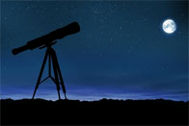| Radial Velocity |
The movement of an object either towards or away from a stationary observer. |
| Radiant |
A point in the sky from which meteors in a meteor shower seem to originate. |
| Radiation |
Energy radiated from an object in the form of waves or particles. |
| Radiation Belt |
Regions of charged particles in a magnetosphere. |
| Radio Galaxy |
A galaxy that gives off large amounts of energy in the form of radio waves. |
| Red Giant |
A stage in the evolution of a star when the fuel begins to exhaust and the star expands to about fifty times its normal size. The temperature cools, which gives the star a reddish appearance. |
| Redshift |
A shift in the lines of an object's spectrum toward the red end. Redshift indicates that an object is moving away from the observer. The larger the redshift, the faster the object is moving. |
| Reflecting |
Using mirrors (as opposed to lenses) |
| Reflecting & Refracting |
Catadioptric |
| Reflecting telescope |
Catoptric |
| Refracting |
Using lenses (as opposed to mirrors) |
| Refracting telescope |
Dioptric |
| Regular Satellite |
A satellite that orbits close to a planet in a nearly circular, equatorial orbit. Regular satellites are believed to have been formed at the same time as the planet, unlike irregular satellites which are believed to have been captured by the planet's gravity. |
| Resonance |
A state in which an orbiting object is subject to periodic gravitational perturbations by another. |
| Retrograde Motion |
The phenomenon where a celestial body appears to slow down, stop, them move in the opposite direction. This motion is caused when the Earth overtakes the body in its orbit. |
| Retrograde Orbit |
The orbit of a satellite where the satellite travels in a direction opposite to that direction of the planet's rotation. |
| Rigel |
A star - Beta Orionis |
| Right Ascension |
The amount of time that passes between the rising of Aries and another celestial object. Right ascension is one unit of measure for locating an object in the sky. |
| Ring Galaxy |
A galaxy that has a ring-like appearance. The ring usually contains luminous blue stars. Ring galaxies are believed to have been formed by collisions with other galaxies. |
| Roche Limit |
The smallest distance from a planet or other body at which purely gravitational forces can hold together a satellite or secondary body of the same mean density as the primary. At a lesser distance the tidal forces of the primary would break up the secondary. |
| Rotation |
The spin of a body about its axis. |

